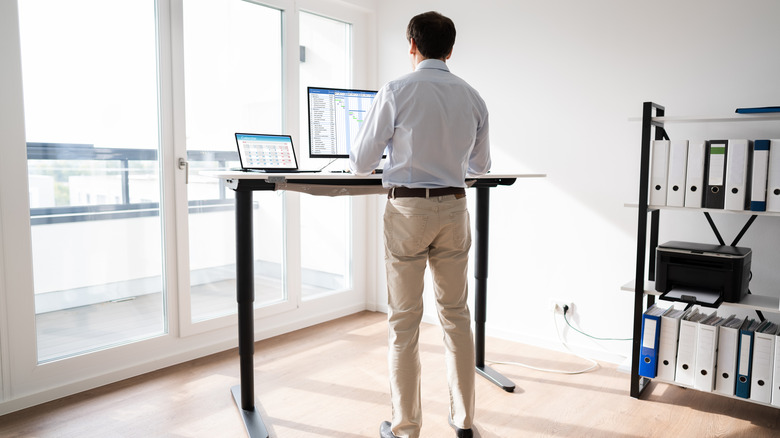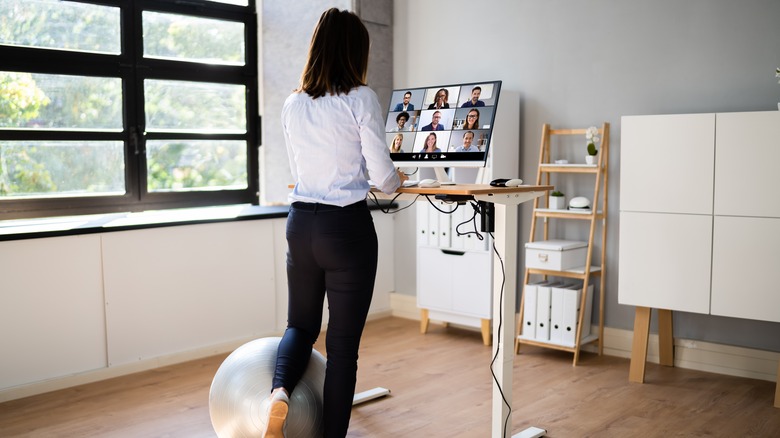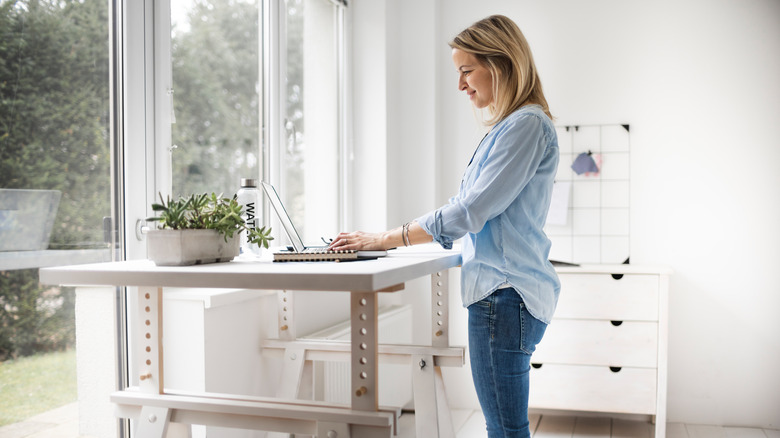5 Benefits Of Standing Desks For Remote Workers
While many remote workers cherish the ability to sit down at work, studies have shown that too much sitting can be terrible for your posture and for your health. WebMD notes that sitting all day long can increase the risk of heart disease, increase the likelihood of dementia, and even shorten your lifespan.
Fortunately, a viable and simple solution is available: the standing desk. This is one of the best "work setup upgrades" for those of us who stare at a laptop all day. Work itself is supposed to be a productive endeavor that provides us with the financial ability to sustain and improve our lifestyle while also contributing to the forward momentum of society at large. Increasing the chance of impending health issues is certainly counterintuitive to that.
As remote work continues to gain steam, creating a home office setup that allows for both comfort and productivity is increasingly important. A standing desk is a key component of an optimized remote work setup.
What is a standing desk?
Standing desks, or adjustable height desks, as you may have heard them called, are intended to offset those health problems by increasing blood flow and improving posture. In practice, standing desks are exactly as the name suggests –- work desks that adjust to different heights so that you can alternate between standing and sitting throughout the day. They've become quite the hot topic since the beginning of the COVID-19 pandemic and the subsequent rise of remote work.
What may seem a novel idea actually has quite an impressive history. The standing desk was first used way back in the 1400s by none other than Leonardo DaVinci, according to Stand Up Desk Store. The acclaimed artist would often stand up while working on his paintings. Fast forward a few hundred years and such names as Ernest Hemingway, Charles Dickens, and Winston Churchill became known for rigging their work desks in favor of a standing setup.
But it was in the 2000s that the modern standing desk became commonplace. Undoubtedly furthered by parodies on the doldrums of desk culture such as "Office Space," these work desks began appearing more regularly around 2010, when "sitting disease" was coined by researchers.
In giving their users the option to stand up throughout the day, standing desks began making a mark on popular culture both for health reasons and because, sometimes, it just feels good to stand up to the task. Let's dive deeper into the health benefits of standing desks.
Better posture
Texas-based insurance agency Germania Insurance points out that the average office worker sits hunched over their desk for nearly nine hours per day (8.8 hours, to be exact). If you've ever felt your shoulders tightening and your wrists creaking by mid-week, your bad desk posture could very well be the culprit.
Standing intermittently throughout the day helps you keep your limbs and joints loose, as you'll inevitably be more active when standing than you are while sitting. You'll be more likely to shift positions, for example, and perhaps adopt a rhythmic sway of the hips as you type or scroll through emails.
Speaking of hunching, you also won't need to do nearly as much of it. For proper neck posture, you should be looking across at your computer screen rather than down, according to Spine Universe. Most standing desks can be adjusted to different heights, allowing you to find a setting that suits your height and comfort level for working.
Improved focus
All this hip-swaying and ankle clicking gets your blood moving more actively than sitting down with shoulders hunched over the keyboard. According to the site Virtual Imaging, poor circulation prevents ample blood from reaching the brain. This, of course, reduces brainpower, which can have significant impacts both on the quantity of work you get done and on the quality of that work.
With good circulation comes a better ability to focus. And when you can focus, you can work through tasks in a more efficient manner while simultaneously achieving better results. You'll also feel better about the work you've completed, as proper blood flow to the brain helps to stimulate deeper thinking, including surrounding feelings of accomplishment (via Scientific American). Add a standing desk to your routine now and by the time the next raise review comes along, you very well may have significantly boosted your output to the point that the boss has no choice but to notice.
Standing intermittently is better for your long-term health
The World Health Organization (WHO) has found that leading a sedentary lifestyle — one that is inactive — increases "all causes of mortality, double the risk of cardiovascular diseases, diabetes, and obesity, and increase the risks of colon cancer, high blood pressure, osteoporosis, lipid disorders, depression and anxiety."
Using a standing desk also helps alleviate at least some of the negative effects of a sedentary lifestyle because standing burns more calories than sitting (up to 88 calories per hour, in fact), WebMD notes. Standing also helps your blood sugar return to normal faster after eating and generally boosts circulation throughout the body.
It can be tough to get the blood moving at all given how exhausted you may feel at the end of a long workday. By spending even 30 minutes standing at a few intervals throughout the day, you're alleviating –- or at least postponing –- many of the health risks of a sedentary lifestyle. Research cited by CNN in 2015 showed you should sit for 20 minutes out of each 30, stand for eight, and move around for two. That amounts to just over an hour of standing throughout an eight-hour workday — a good benchmark to work towards as you progress in your standing work routine.
Avoid sitting disease
According to the Mayo Clinic, those who sit for longer than eight hours per day without any physical activity have about the same risk of premature death as those who are smokers or who are obese. That's because of what researchers have dubbed "sitting disease," a broad term that is actually linked to 34 different conditions associated with excess sitting and a lack of physical activity.
Adding a standing desk to your remote work setup –- and actually using it –- prevents you from entering the realm of the "over-sitter." In addition to reducing your risk of dementia and heart problems, as noted above, standing up more can also reduce the risk of certain types of cancers (per ASC).
If you have a treadmill, you can give "sitting disease" the full-on boot by positioning your standing desk above the treadmill and embarking on a light walk while doing tasks such as reading.
Change your view (and your outlook)
We all get tired of the same view during the workday. For this writer, that view is of a laptop on a stand, backed by a pasty white wall. Yes, I can turn around and look out the window –- but I can't face the desk in that direction because of the inevitable sunshine blinding me from seeing the screen.
What I can do, however, is stand up intermittently. Doing so not only gets the blood going and works off a few extra calories, but it also provides a fresh perspective on my mundanely outfitted home office.
A simple change in perspective such as this can entirely shift the mood, according to Forbes, and while most studies surrounding this are in reference to office workers, there's a lot to be said about slight shifts in perspective for remote workers, too. Computer workers should look away from their computer screen every 20 minutes, WebMD notes, and standing up may give you an entirely new perspective on that piece of art hanging on the wall or allow you to glimpse what the dog is up to outside in the yard.
At the very least, standing makes it a lot easier to do a quick stretch and take a deep breath.






